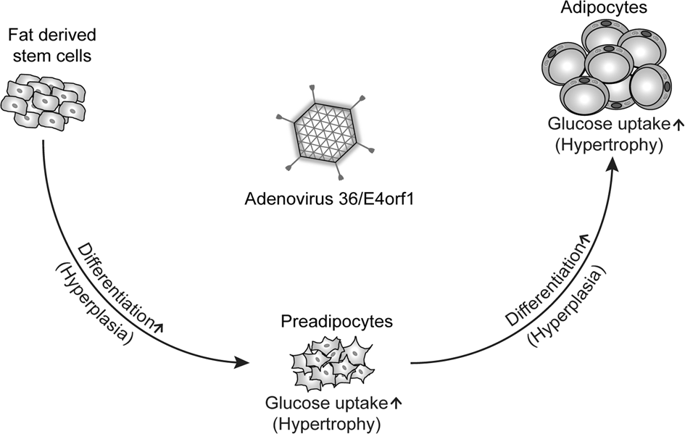当前位置:
X-MOL 学术
›
Int. J. Obesity
›
论文详情
Our official English website, www.x-mol.net, welcomes your
feedback! (Note: you will need to create a separate account there.)
What we know and what we need to know about adenovirus 36-induced obesity.
International Journal of Obesity ( IF 4.2 ) Pub Date : 2020-01-15 , DOI: 10.1038/s41366-020-0536-4 Jihye Kim 1 , Hana Na 2 , Jung-Ae Kim 3, 4 , Jae-Hwan Nam 5
International Journal of Obesity ( IF 4.2 ) Pub Date : 2020-01-15 , DOI: 10.1038/s41366-020-0536-4 Jihye Kim 1 , Hana Na 2 , Jung-Ae Kim 3, 4 , Jae-Hwan Nam 5
Affiliation

|
BACKGROUND
Many internal and external factors are related to obesity. Pathogens that can induce obesity are the most interesting external factors. While the relationship between pathogenic human intestinal microbiota and obesity has been extensively studied, viruses have received relatively little attention. Among the human obesity-related viruses, adenovirus 36 (Ad36) is most commonly associated with obesity.
METHODS
A literature search was conducted using the articles in the PubMed database published from April 1982 to April 2019. The following main keywords were used: ('adenovirus 36') and ('obesity') and ('cellular mechanism' or 'genetic factor' or 'immune response' or 'inflammation').
RESULTS
In this review, we have discussed the known facts and what requires to be understood regarding Ad36-induced obesity. In particular, we have summarized the cellular mechanism of Ad36-induced obesity, as well as the genetic and immunological factors affected by Ad36 infection. Ad36 infection increases adipogenesis in animals and humans. Ad36-induced inflammation contributes to angiogenesis in adipose tissues, thereby maintaining proper glycemic control and metabolic robustness. The E4orf1 protein derived from Ad36 is responsible for increasing glucose uptake due to the translocation of GLUT4 via the Ras-PI3K pathway, which is involved in 'distal' insulin signaling.
CONCLUSIONS
We expect that this review will assist in guiding future investigations regarding Ad36-induced obesity. (1) Identification of the direct and indirect factors affecting Ad36-induced obesity and understanding their mechanism of action and (2) utilization of the Ad36-induced improvement in glycemic control for clinical applications, with efforts toward developing E4orf1-based drugs.
中文翻译:

关于腺病毒 36 引起的肥胖,我们知道什么,我们需要知道什么。
背景许多内部和外部因素与肥胖有关。可诱发肥胖的病原体是最有趣的外部因素。虽然致病性人类肠道微生物群与肥胖之间的关系已得到广泛研究,但病毒受到的关注相对较少。在人类肥胖相关病毒中,腺病毒 36 (Ad36) 最常与肥胖相关。方法 使用 PubMed 数据库中 1982 年 4 月至 2019 年 4 月发表的文章进行文献检索。使用以下主要关键词:(“腺病毒 36”)和(“肥胖”)和(“细胞机制”或“遗传因素” '或'免疫反应'或'炎症')。结果 在本次审查中,我们已经讨论了有关 Ad36 诱导的肥胖症的已知事实以及需要了解的内容。特别是,我们总结了 Ad36 诱导肥胖的细胞机制,以及受 Ad36 感染影响的遗传和免疫学因素。Ad36 感染会增加动物和人类的脂肪生成。Ad36 诱导的炎症有助于脂肪组织中的血管生成,从而维持适当的血糖控制和代谢稳健性。源自 Ad36 的 E4orf1 蛋白负责增加葡萄糖摄取,这是由于 GLUT4 通过 Ras-PI3K 途径易位,这涉及“远端”胰岛素信号传导。结论 我们希望该评价将有助于指导未来有关 Ad36 诱导的肥胖症的调查。
更新日期:2020-01-15
中文翻译:

关于腺病毒 36 引起的肥胖,我们知道什么,我们需要知道什么。
背景许多内部和外部因素与肥胖有关。可诱发肥胖的病原体是最有趣的外部因素。虽然致病性人类肠道微生物群与肥胖之间的关系已得到广泛研究,但病毒受到的关注相对较少。在人类肥胖相关病毒中,腺病毒 36 (Ad36) 最常与肥胖相关。方法 使用 PubMed 数据库中 1982 年 4 月至 2019 年 4 月发表的文章进行文献检索。使用以下主要关键词:(“腺病毒 36”)和(“肥胖”)和(“细胞机制”或“遗传因素” '或'免疫反应'或'炎症')。结果 在本次审查中,我们已经讨论了有关 Ad36 诱导的肥胖症的已知事实以及需要了解的内容。特别是,我们总结了 Ad36 诱导肥胖的细胞机制,以及受 Ad36 感染影响的遗传和免疫学因素。Ad36 感染会增加动物和人类的脂肪生成。Ad36 诱导的炎症有助于脂肪组织中的血管生成,从而维持适当的血糖控制和代谢稳健性。源自 Ad36 的 E4orf1 蛋白负责增加葡萄糖摄取,这是由于 GLUT4 通过 Ras-PI3K 途径易位,这涉及“远端”胰岛素信号传导。结论 我们希望该评价将有助于指导未来有关 Ad36 诱导的肥胖症的调查。










































 京公网安备 11010802027423号
京公网安备 11010802027423号